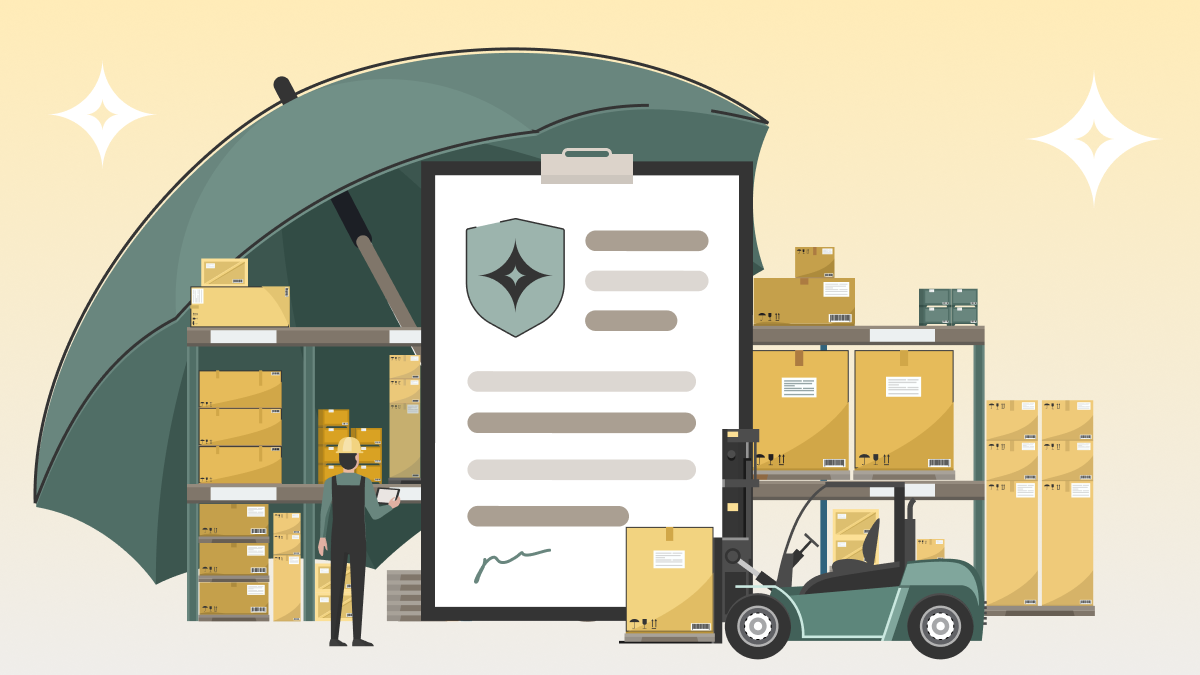Blanket Insurance: Understanding All Aspects of This Coverage Type
Imagine having a safety net that stretches across all your valuable assets, securing everything from your property to your precious equipment under one protective umbrella. This is the essence of blanket insurance – a single policy designed to cover a variety of assets, simplifying your protection strategy.
In this blog, we'll peel back the layers of blanket insurance, examining its coverage options, benefits, and costs. You'll gain valuable insights to determine if this comprehensive coverage is the ideal fit for your needs. Let's embark on this journey to unravel the protective power of blanket insurance.
What Is Blanket Insurance?
Blanket insurance is a type of policy that offers broad coverage for multiple assets, such as different properties, inventory, equipment, and liabilities, under one policy. Instead of having separate insurance for each asset, blanket insurance covers all the assets under one policy.

For individuals, imagine you own a home, a vacation cabin, and several valuable pieces of art. Instead of insuring each of these separately, blanket insurance can cover them all under one policy.
Similarly, for businesses with multiple locations, equipment types, and inventory, blanket insurance can protect all these assets.
With blanket insurance, managing your insurance is easier because you're dealing with one policy that covers everything. One key feature of blanket insurance is the 'single policy limit.' This is the maximum amount the insurance company will pay out for all covered losses under the policy. This collective limit applies to everything from property damage and inventory loss to liability claims.
How Blanket Insurance Works
Picture this: instead of handling multiple policies for each insured asset, you have just one policy covering everything. Consider a coffee shop owner who has multiple locations in different cities. They opted for blanket insurance to cover all the tangible assets associated with the business, including the buildings, equipment, furniture, and inventory across all locations.
Suppose the blanket insurance policy has a total coverage limit of $2 million, covering all assets across five locations. A severe storm causes significant damage to one of the coffee shops. The damage includes structural damage to the building, destroyed equipment, and ruined inventory, with an estimated loss of $500,000.
Following the storm, the owner files a claim for the damage to the coffee shop. The blanket insurance policy covers all of the coffee shops and their contents as a single entity under the $2 million limit. Therefore, the damage to the coffee shop, including the building, equipment, and inventory, falls under the policy's coverage.
Because the policy has a single aggregate limit, it does not matter that the damage occurred to different categories of assets. The insurance company approves the claim and compensates the $500,000 loss. This amount is deducted from the total coverage limit, leaving $1.5 million in coverage for future claims during the policy term.
Types of Blanket Insurance
Blanket insurance offers a wide-ranging shield for various assets tailored to meet the distinct needs of both businesses and individuals. Here are the different types of blanket insurance coverage you can obtain:

For Businesses:
- Commercial Property: Protects all of a business's locations under one policy. This is ideal for businesses with multiple premises, ensuring uniform coverage across all properties against common risks like fire, theft, or natural disasters.
- Inventory: Safeguards fluctuating stock levels against loss, damage, or theft.
- Equipment: Covers operational tools, from manufacturing machinery to office technology, against breakdowns or accidental damage.
- General Liability: Protects against claims related to property damage or personal injury caused by the business's operations, products, or services.
For Individuals:
- Residential Property: Insures multiple properties, including primary residences and vacation homes, under a unified policy for simplified management.
- Personal Property: Covers valuable personal belongings, such as electronics and jewelry, beyond standard policy limits.
The Benefits of a Blanket Insurance Policy
Choosing a blanket insurance policy offers the following advantages:
- Simplicity in Management: Blanket insurance consolidates all your coverage needs into a single policy. This approach makes managing your insurance straightforward, saving you time and reducing the complexity of overseeing multiple policies.
- Uniform and Comprehensive Coverage: With blanket insurance, you won't have to worry about some assets being more protected than others. This policy ensures that all your assets are covered uniformly under one umbrella. This comprehensive coverage minimizes the risk of encountering uninsured losses, offering a robust safety net for all your properties or items.
- Cost Efficiency: Blanket insurance combines various coverages into one, often leading to lower overall costs than buying separate policies for each asset.
- Higher Limits: Blanket policies typically offer higher coverage limits than individual policies. While these limits are shared across all covered assets, they generally range higher, giving you a more substantial safety net. However, remember that this is a total limit, applying cumulatively to all covered assets.
- Customizability: This type of insurance allows for some flexibility regarding what is covered. You can work with your insurer to tailor your policy to your specific needs, ensuring that your coverage matches your asset portfolio.
- Streamlined Claims Process: When dealing with damages or losses involving multiple types of assets, having blanket policy insurance can simplify the claims process. This unified approach can make addressing and settling claims related to various assets easier under one policy.
The Disadvantages of Blanket Insurance
While blanket insurance offers numerous benefits, it's also important to consider its potential drawbacks to ensure it aligns with your needs:
- Less Individualized Coverage: While blanket insurance offers broad coverage, it may not address the specific needs of each asset as precisely as individual policies. This generalized approach might overlook unique risks associated with certain assets, potentially leaving some areas less protected than you might prefer. For example, high-value artwork or specialized machinery may require more tailored coverage than what blanket insurance provides.
- Choosing Limits: Determining the right coverage limit for a blanket policy can be challenging, especially when it spans assets of varying values. Setting a limit that is too low could mean not all losses are covered, particularly for claims involving multiple assets.
- Aggregate Coverage Limitations: Since blanket insurance operates on an aggregate limit shared among all covered assets, there might not be enough funds to cover all losses after a major incident.
- Exclusions: Like all insurance policies, blanket insurance has exclusions. Common ones might include natural disasters like floods, earthquakes, and intentional damage.
How Much Does Blanket Coverage Cost?
Determining the cost of blanket coverage insurance is not a one-size-fits-all matter and will depend on what assets you’re covering and the value. However, you should expect to spend more for convenience.
However, your premiums may vary based on the following factors:
- Type and Value of Assets: The nature and worth of the assets you're insuring play a significant role. High-value assets or those prone to risks may increase the cost of your policy.
- Coverage Limit: The total amount of coverage you opt for will impact the price. Higher limits offer more protection but also come at a higher cost.
- Risk Level: The inherent risk associated with your assets, including location, type of asset, and the potential for damage or loss, will influence the insurance cost. Higher risk typically translates to higher premiums.
Scheduled vs. Blanket Insurance
Scheduled insurance targets specific items for coverage, while blanket insurance covers a wide range of assets under one policy. Here's a comparison of blanket coverage vs. scheduled to guide you:
|
|
Scheduled Coverage |
Blanket Coverage |
|
Definition |
Insurance coverage where individual assets are listed (scheduled) with specific coverage limits for each. |
Insurance coverage that provides a single coverage limit for all covered assets without specifying individual limits. |
|
Coverage Limits |
Specific limits are assigned to each asset. |
A single aggregate limit applies to all covered assets, allowing flexibility in how the limit is used across claims. |
|
Premiums |
Premiums are based on the value and risk of each individual listed asset. |
Premiums are determined by the total value of all covered assets and the overall risk. |
|
Flexibility in Claims |
Less flexibility, as each item has a fixed coverage limit. Overages on one item cannot be covered by underages on another. |
Greater flexibility, as the total coverage can be applied to any covered loss, regardless of which asset is involved. |
|
Management |
Requires detailed management and updating as items are added or removed or their values change. |
Simplified management with less need for frequent updates unless the total value of covered assets significantly changes. |
|
Risk of Underinsurance |
Higher risk if individual items are undervalued or if specific limits are not regularly updated. |
Reduced risk of underinsurance for individual items, but there's a need to ensure the aggregate limit is sufficient for all covered assets. |
|
Suitability |
Ideal for insuring high-value or unique items that require specific valuation and coverage (e.g., art, jewelry, specialized equipment). |
Suitable for covering multiple similar items or properties, offering broad protection without the need for itemization (e.g., inventory, multiple locations). |
|
Claims Process |
Claims are settled based on the value of each item, requiring detailed documentation and valuation. |
Claims are settled up to the aggregate limit, potentially simplifying the process but requiring careful allocation of the blanket limit across losses. |
Blanket Insurance vs. Umbrella Insurance
Umbrella insurance is like an extra shield for your finances, stepping in when your usual insurance doesn't cover all the costs of a big claim. Imagine you have a car insurance policy that covers up to $300,000, but you're involved in an accident where the damages and medical bills total $500,000.
If you have umbrella insurance, it can cover the extra $200,000 that your car insurance doesn't, protecting you from having to pay out of your own pocket. But it’s not just for auto insurance, umbrella insurance also fills the gaps in general liability and homeowners’ insurance, too.
 Beyond just covering the overflow from other policies, umbrella insurance typically includes claims that may be excluded from your primary policies. Umbrella policies usually start at $1 million in coverage and often offer worldwide coverage.
Beyond just covering the overflow from other policies, umbrella insurance typically includes claims that may be excluded from your primary policies. Umbrella policies usually start at $1 million in coverage and often offer worldwide coverage.
Blanket insurance covers multiple assets under one policy, ideal for broad asset protection with a single coverage limit. Umbrella insurance, on the other hand, extends liability coverage beyond existing policy limits, filling in coverage gaps and including some claims not covered by primary policies. These differences make blanket insurance suitable for asset consolidation, while umbrella insurance offers an extra layer of liability protection.
How to Get the Right Blanket Coverage for You
Securing the right blanket coverage is a strategic process that ensures your assets are adequately protected. Here's a step-by-step guide to help you navigate through this decision:
- Thoroughly Assess Needs and Asset Risks: Start by making a detailed list of all assets requiring insurance coverage, such as properties, vehicles, equipment, and inventory. For each asset, identify potential risks, considering factors like location, use, and value. This step is about knowing exactly what you're protecting and what could possibly go wrong.
- Accurately Determine Coverage Requirements: Calculate your assets' total value to understand the coverage you'll need. This isn't just about how much your assets are worth now but how much it could cost to replace them if lost or damaged. Decide on an adequate coverage limit, keeping in mind to cover the full scope of potential risks.
- Diligently Research Insurers and Policies: Spend time researching various insurers, focusing on those known for reliable blanket coverage. Compare their offers, but go beyond price comparisons. Consider their reputation for handling claims, customer service quality, and reviews or testimonials. Utilizing online comparison websites can streamline this process.
- Deep Dive into Policy Details: Once you've selected a few potential insurers, examine their policies closely. Pay attention to premiums, but also look into what is covered and what isn't (the exclusions), the limits of coverage, and if any gaps could leave you exposed. This might involve reading the fine print and possibly consulting with an insurance advisor for clarification.
- Commit to Regular Policy Reviews and Updates: As your needs and assets evolve, so should your insurance coverage. Establish a routine for reviewing your policy annually or whenever significant asset changes occur. This ensures your coverage accurately reflects your current situation, adjusting as needed for new acquisitions or changes in asset values.
Bottom Line
Blanket insurance is a practical choice for broad coverage that bundles protection for various assets under one policy. It's about balancing ease with thoroughness. While it offers extensive protection, remember to consider how it aligns with your specific needs and budget.
Understanding blanket insurance fully means you're better positioned to make an informed choice, ensuring your assets are protected in a way that suits your lifestyle and financial plan. The right coverage is about making sure you're comfortably covered today and secure in the future.
Sources
- Forbes. “Why You Should Consider Scheduled Personal Property Coverage.” Accessed Jan. 6, 2024.
- Nerdwallet. “What Is Umbrella Insurance, and How Does It Work?” Accessed Jan. 6, 2024.



